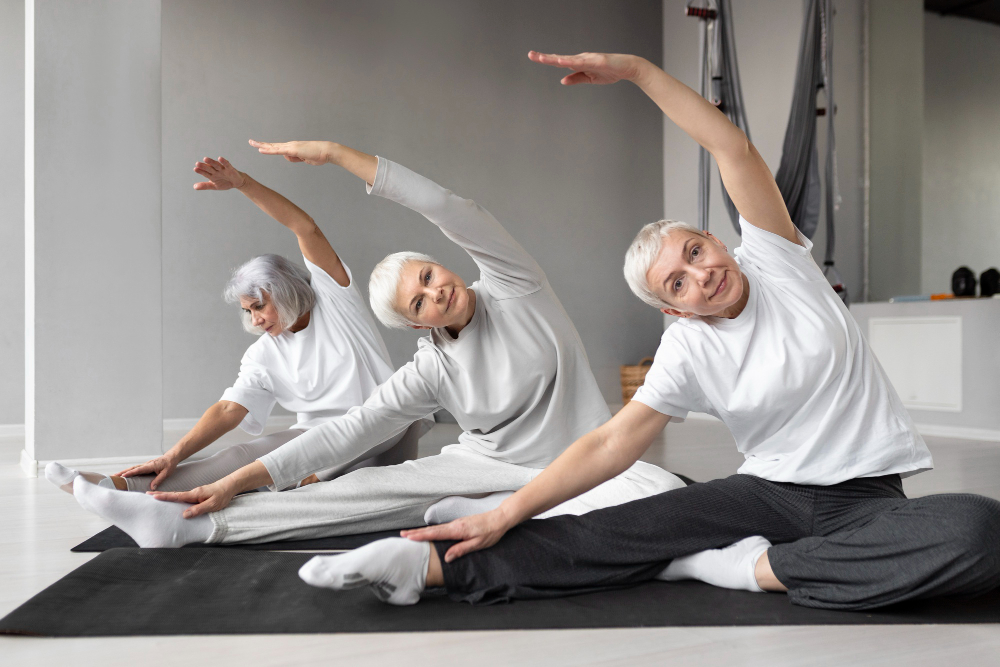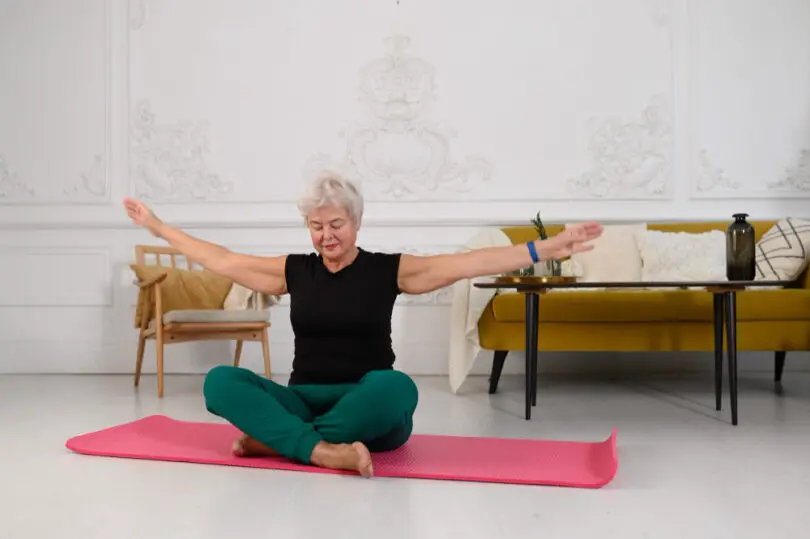Table of Contents
Introduction
Yoga is an excellent practice for people of all ages, but it can be particularly beneficial for seniors. It improves flexibility, balance, and strength while providing mental relaxation and emotional well-being. This article will guide you through a gentle and safe yoga sequence suitable for seniors, helping you develop a practice that supports your unique needs.
Benefits of Yoga for Seniors
Yoga offers numerous benefits for seniors, addressing both physical and mental well-being. Here are some key advantages:
- Improved Flexibility: Gentle stretching helps maintain or improve flexibility, which can reduce stiffness and enhance movement.
- Better Balance: Balance-focused poses can lower the risk of falls by strengthening and stabilizing muscles and improving coordination.
- Joint Health: Gentle yoga can increase circulation around joints, reducing discomfort and promoting joint mobility.
- Strength Building: Yoga uses body weight for resistance, which can help build and maintain muscle strength.
- Reduced Stress: Breathing exercises and meditation can help lower stress levels and promote relaxation.
- Better Sleep: Regular practice can contribute to better sleep by calming the nervous system and reducing insomnia.
- Pain Relief: Yoga can alleviate chronic pain conditions like arthritis, thanks to its low-impact nature.
- Cardiovascular Health: Regular yoga can improve heart health by lowering blood pressure and reducing the heart rate.
- Social Engagement: Attending classes or online sessions can offer a sense of community and social connection.
- Mental Clarity: Meditation and breathing practices support focus, memory, and cognitive function.
These benefits make yoga an excellent practice for seniors seeking to maintain their health and quality of life.
Preparing for Practice
When preparing for yoga as a senior, it’s important to create a safe and enjoyable environment. Here are some tips:
- Consult a Doctor: Before starting yoga, speak with a healthcare provider to understand any limitations or modifications needed.
- Choose the Right Class: Look for classes specifically geared towards seniors or beginners. Chair yoga or gentle yoga classes are often ideal.
- Gather Equipment: Common props like a yoga mat, sturdy chair, yoga blocks, straps, or bolsters can help with support and comfort.
- Wear Comfortable Clothing: Wear loose, breathable clothing that allows free movement.
- Start Slowly: Begin with short sessions and gradually build endurance. Focus on gentle poses to ease into the practice.
- Warm-Up: Begin with simple stretches or gentle movements to warm up the muscles and joints.
- Practice Deep Breathing: Incorporate deep breathing techniques to promote relaxation and mental focus throughout the session.
- Listen to Your Body: Modify or skip poses that cause pain or discomfort. The goal is to move comfortably within your range.
- Stay Hydrated: Drink water before and after your practice to stay hydrated.
- Have a Calm Space: Choose a quiet space for practice to maintain focus and avoid distractions.
These preparations can ensure a safe and fulfilling yoga practice, enabling seniors to enjoy the physical and mental benefits fully.

Create a Comfortable Space
Creating a comfortable space for seniors to practice yoga is essential to help them feel safe, relaxed, and focused. Here are some suggestions:
- Quiet Environment: Choose a quiet room or corner where seniors can practice without interruptions or excessive noise.
- Non-Slip Surface: Ensure the floor is safe and stable. If using a mat, choose one that is thick and non-slip to offer cushioning and grip.
- Natural Light: Natural light helps with relaxation. If possible, set up the space near a window, but avoid direct sunlight that might cause glare.
- Calming Colors: Surround the area with soothing, neutral colors to create a serene atmosphere.
- Props Within Reach: Keep yoga props like blocks, straps, chairs, and bolsters nearby for easy access.
- Temperature Control: Make sure the room is not too hot or cold to avoid discomfort.
- Plants and Scents: If possible, place a few plants around for a natural feel. Essential oils like lavender can provide a calming aroma if safe for use.
- Comfortable Seating: Provide a supportive chair or bench for seated poses or resting.
- Music or Meditation: Gentle music or guided meditation can enhance the ambiance and help with focus.
- Clear Space: Ensure there’s ample room to move freely without obstacles.
This setup will make the space inviting and peaceful, encouraging seniors to enjoy and stick with their yoga practice.
The Yoga Sequence
A yoga sequence for seniors should be gentle and accessible, focusing on safe stretching, balance, and relaxation. Here is a simple sequence:
- Warm-Up (5 minutes)
- Seated or Standing Breath Work: Sit or stand comfortably and practice deep breathing, inhaling through the nose and exhaling through the mouth.
- Gentle Neck Rolls: Slowly tilt the head to the sides and forward to loosen up the neck.
- Seated or Standing Stretches (10 minutes)
- Seated Cat-Cow: Sit on a chair or stand with feet hip-width apart. Arch the spine on the inhale, then round on the exhale, following the breath.
- Side Stretch: Raise one arm overhead and lean gently to the opposite side, then switch.
- Chair or Wall Poses (15 minutes)
- Chair or Wall Warrior I: Use the chair for balance and step one leg back to create a lunge position, keeping the front knee bent. Raise both arms overhead.
- Chair or Wall Tree Pose: Stand with one hand on the chair or wall. Shift weight to one leg, placing the other foot on the ankle or calf of the standing leg. Raise the opposite arm overhead.
- Floor Poses (if accessible) (15 minutes)
- Supine Knee-to-Chest: Lie on the back and draw one knee to the chest, then switch legs.
- Reclining Bound Angle Pose: Lie on the back and bring the soles of the feet together, allowing the knees to open wide.
- Cool-Down and Relaxation (10 minutes)
- Legs-Up-the-Wall Pose: Sit sideways against a wall, then lie back and swing your legs up the wall. Stay here for a few minutes.
- Savasana: Lie on the back, with arms at the sides and palms facing up. Focus on breathing and relaxing each muscle.
This sequence provides a well-rounded, gentle practice, incorporating breath work, stretching, strengthening, and relaxation. Adjust it as needed to accommodate specific limitations.
FAQs
What type of yoga is best for seniors?
For seniors, gentle forms of yoga are often the most suitable. Here are a few recommendations:
Hatha Yoga: Focuses on gentle poses, breathing, and meditation, making it beginner-friendly.
Chair Yoga: Offers seated poses that are ideal for those with mobility issues.
Restorative Yoga: Utilizes props like bolsters and blankets for longer, supported poses to encourage relaxation.
Iyengar Yoga: Emphasizes alignment and uses props to make poses more accessible.
Viniyoga: Adapts poses to meet individual needs and conditions, which can be particularly beneficial for seniors.
Is 70 Too Old to Start Yoga?
No, 70 is not too old to start yoga! With proper guidance and adaptations, yoga can be safely practiced by seniors, regardless of age. The key is to choose the right type of yoga, start slowly, and listen to the body’s needs.
What are the 5 sequences of a yoga class?
A typical yoga class generally follows these sequences:
Centering: Begin with breath awareness, setting an intention, and gentle warm-ups.
Standing Poses: Engage the legs, core, and balance with foundational poses like Warrior, Tree, and Triangle.
Seated Poses: Move to the ground for hip openers and gentle twists.
Backbends and Forward Folds: Focus on lengthening the spine and improving flexibility.
Cool Down and Relaxation: Finish with gentle stretches and Savasana to relax and integrate.
What is the correct sequence of yoga?
A balanced yoga sequence usually follows these steps:
Warm-Up: Gentle stretches and breath work to prepare the body.
Standing Poses: Build strength and balance while engaging major muscle groups.
Seated and Reclining Poses: Stretch the hips, hamstrings, and back.
Inversions (optional): Modify based on the ability to include poses like Downward Dog or Legs-Up-the-Wall.
Backbends: Gentle or moderate backbends to open the front body.
Twists: Neutralize the spine and aid digestion.
Final Relaxation: Savasana for relaxation and meditation.
These guidelines help provide a consistent and safe approach to yoga practice.
Conclusion
Incorporating this gentle yoga sequence into your routine will not only improve flexibility and strength but also enhance mental clarity and emotional well-being. Remember, progress may be gradual, so listen to your body and practice consistently.
Related Article:
To enhance your journey in senior yoga, consider these resources:
- Enhancing Wellness: Discover the power of chair yoga with “Chair Yoga for Seniors: A Free Guide to Enhanced Wellbeing.”
- Develop a Practice: Learn to create a holistic routine with “Creating a Yoga Practice: A Comprehensive Guide.”
- Online Classes: Access quality instruction with these “Free Online Yoga Classes.”







